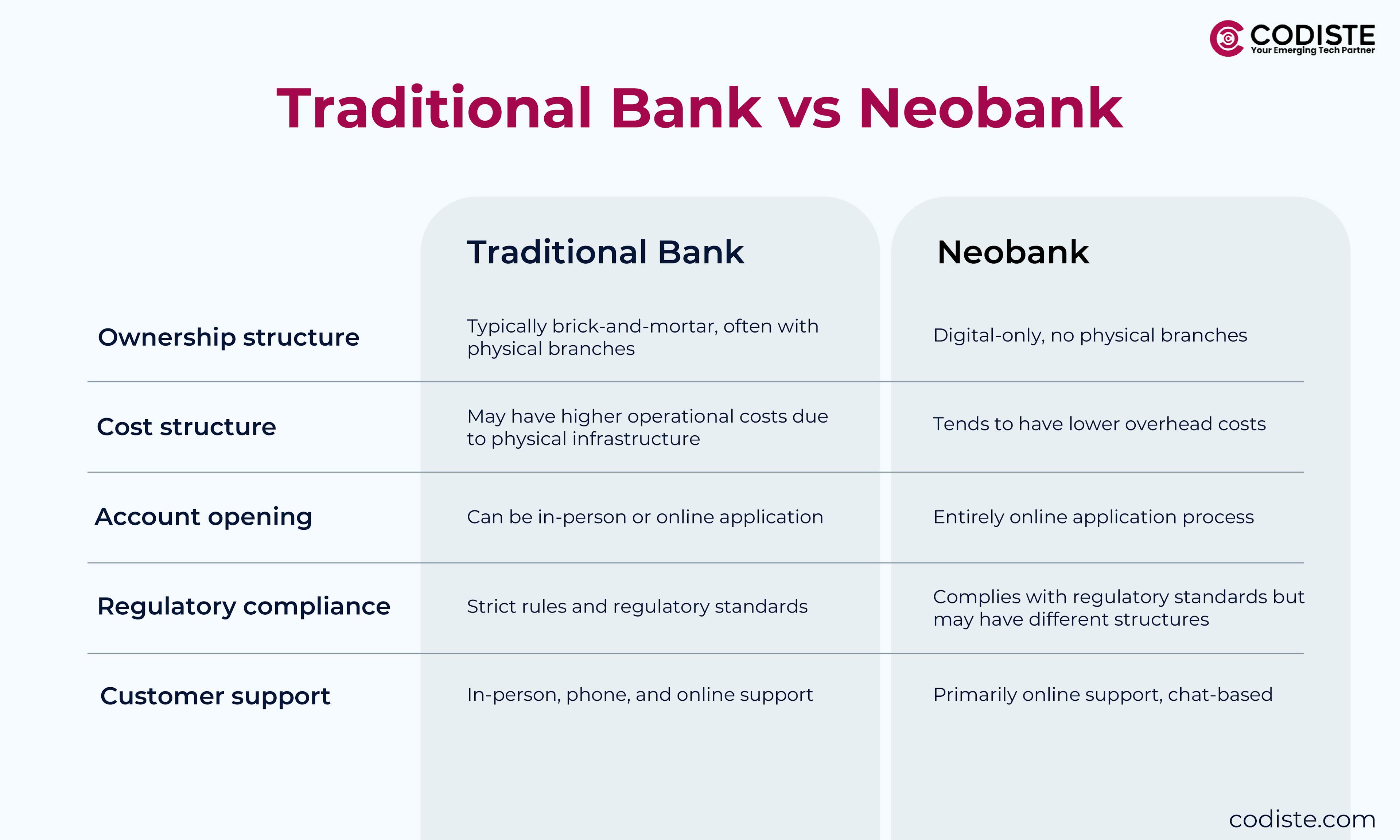
,
TL;DR
- Innovation race is evolving - Neobanks lead in speed and UX while traditional banks leverage regulatory expertise and capital resources
- Customer experience differs fundamentally - Neobanks prioritize friction elimination, traditional banks balance comprehensive service with digital efficiency
- AI implementation varies strategically - Neobanks integrate AI as core infrastructure, traditional banks focus on specific use case enhancement
- Regulatory advantages are shifting - Traditional banks maintain compliance expertise while neobanks benefit from innovation-friendly frameworks
- Performance metrics show specialization - Neobanks excel in acquisition and engagement, traditional banks dominate in profitability and asset scale
- Future favors convergence - Banking-as-a-Service and hybrid models combine neobank innovation with traditional bank stability
- Strategic success requires both - Winning approaches leverage digital-first customer experience with operational reliability and regulatory compliance
The fight between neobanks vs traditional banks isn't simply about online banking vs physical offices anymore. It's about alternative ways of thinking about banking technology innovation that are changing how banks work, compete, and help clients in 2025.
By 2025, there were around 394 million neobanking users globally. For traditional banks, 77% of checking account holders were active digital banking users in 2025. This confluence shows that the race for invention has moved past the classic story of David vs. Goliath and into something much more complex.
The question here isn't whether neobanks will take the place of traditional banks. Instead, it's about which new ideas will shape the future of financial services and what that implies for entrepreneurs, strategists, and investors who want to get ahead in this fast-changing field.
Digital Transformation in Banking via Neobanks
Digital transformation in banking has given neobanks unique competitive advantages that they use as fundamental differentiators instead of extra features. Their architecture-first strategy lets them do things that older banks have a hard time doing with their old systems.
There is a big difference in timing. Neobanks can add new features in weeks, but traditional banks need months or quarters. It's not only about being agile; it's also about making innovation a part of the foundation instead of adding it on top.
Where Neobanks Dominate The Innovation Race:
- Cloud-native architecture that lets you quickly add new features and scale up
- API-first architecture that makes it easy for third parties to work together and integrate.
- Real-time data processing for instant insights and personalized experiences
- Mobile-first UX optimized for smartphone-native customer behaviors
- Automated compliance is built into workflows rather than manual oversight processes
Neobanks benefit from lower cost structures, often a fraction of what traditional banks incur, due to minimal physical infrastructure and automation-heavy back ends. This operational efficiency translates directly into innovation velocity that traditional banks find difficult to match.
How Traditional Banks Are Accelerating Digital Transformation
Legacy financial institutions aren't sitting idle while neobanks capture market share. Digital transformation in banking has accelerated dramatically, with traditional banks investing billions in technology modernization and AI in banking capabilities.
The surprise development in 2025 is how effectively some traditional banks have adapted neobank strategies while maintaining their regulatory advantages and customer trust foundations.
The Emerging Innovations In Traditional Banks :
- Regulatory expertise streamlining compliance for new digital products
- Capital resources enabling large-scale technology investments and acquisitions
- Established customer relationships providing data depth for AI-driven personalized banking solutions
- Multi-product ecosystems offering comprehensive financial services integration
- Risk management sophistication built through decades of operational experience
Traditional financial institutions are acting more like neobanks as regulators draw a bead on neobanks, creating competitive dynamics where legacy players adopt challenger strategies while neobanks face increasing regulatory scrutiny.
Customer Experience: The Real Differentiation
Customer experience in banking has become the primary battleground where neobanks vs traditional banks competition plays out most visibly. The difference lies not just in interface design, but in fundamental service philosophy and operational approach.
Neobanks built their entire value proposition around friction elimination. Every process, from account opening to transaction processing, prioritizes speed and simplicity over comprehensive service options.
Neobank UX Advantages That Set Market Expectations:
- Digital onboarding process in banking is completed in minutes versus days or weeks
- Real-time notifications and instant transaction visibility across all channels
- Intuitive mobile interfaces designed for primary smartphone usage patterns
- Automated financial insights providing spending analysis and budgeting tools
- 24/7 digital support through chatbots and AI in banking systems
Traditional banks initially struggled to match this experience quality, but the gap is narrowing rapidly. Big banks now have digital onboarding processes and mobile-first interfaces that are just as good as those at neobanks.
The major difference is still how they prioritize things. Neobanks make every encounter as efficient as possible for digital use, while traditional banks balance digital experience with a wide range of services and the need to follow rules.
AI vs Automation: Which Drives More Innovation in Business?
AI in banking represents the most significant differentiator in the neobanks vs traditional banks innovation race. The approaches, capabilities, and implementation strategies reveal fundamental differences in how these institutions view technology's role.
Neobanks view AI as fundamental infrastructure that is included in all operational procedures and consumer interactions. Within their current operating frameworks, traditional banks selectively apply AI, concentrating on particular use cases.
AI Implementation Strategies Comparison:
Neobank AI integration:
- Financial advice and product recommendations are powered by personalized banking algorithms.
- Real-time transactions are processed by fraud detection systems with few false positives.
- Most support conversations are handled by customer service automation without the need for human intervention.
- Credit scoring models incorporating alternative data sources for expanded lending decisions
- Behavioral analytics predicting customer needs and proactively offering relevant services
Traditional bank AI adoption:
- Risk management enhancement, improving existing compliance and monitoring systems
- Process automation streamlining back-office operations and regulatory reporting
- Customer insights analyzing transaction patterns for marketing and retention strategies
- Cybersecurity advancement protecting legacy systems against sophisticated threats
- Regulatory compliance, automating documentation and reporting requirements
Banks need to move beyond experimentation to transform critical areas, including by reimagining complex workflows with multi-agent systems, indicating that traditional institutions recognize the need for more comprehensive AI integration strategies.
Ready to navigate the evolving banking innovation landscape?
Neobanks vs Traditional Banks: Who Handles Compliance Better
Banking regulation creates a complex innovation environment where neobanks vs traditional banks face different advantages and constraints. This regulatory landscape is shifting rapidly as authorities adapt oversight frameworks to digital-first financial services.
Traditional banks operate with established regulatory relationships and proven compliance systems. Neobanks benefit from newer regulatory frameworks designed for digital financial services, but face increasing scrutiny as they scale.
Regulatory Positioning Analysis:
Traditional bank regulatory advantages:
- Established compliance frameworks proven through decades of regulatory oversight
- Regulatory relationship depth enabling a collaborative approach to new product approvals
- Capital adequacy meets strict requirements for deposit insurance and lending activities
- Operational resilience demonstrated through economic cycles and stress testing
- Cross-border expertise navigating international regulations for global operations
Neobank regulatory positioning:
- Streamlined approval processes for digital-native products and services
- Innovation-friendly frameworks in jurisdictions promoting fintech development
- Partnership flexibility enabling Banking-as-a-Service models with traditional institutions
- Reduced legacy constraints, allowing rapid adaptation to new regulatory requirements
- A concentration on certain areas of regulation instead of all banking rules
The regulatory climate is becoming favorable for institutions that can show both innovative capabilities and operational stability. This balancing poses problems for both neobanks and traditional banks in different ways.
Neobanks vs Traditional Banks: Who’s Winning the Market?

The neobanks vs traditional banks performance metrics reveal a more complex picture than simple growth comparisons suggest. Success depends heavily on how you define winning in the current financial services landscape.
Neobanks excel in user acquisition speed and engagement metrics. Traditional banks dominate in profitability, asset management, and comprehensive service delivery. The market is rewarding different strategies in different segments.
Performance Metrics Comparison:
Neobank strengths:
- Customer acquisition cost is significantly lower than traditional bank acquisition expenses
- Digital engagement rates with 3-5x higher app usage than traditional banking apps
- Feature deployment speed measuring months versus years for new product launches
- Customer satisfaction scores are particularly high among younger demographic segments
- Operational efficiency with cost-to-income ratios favorable due to automation
Traditional bank advantages:
- Revenue per customer is substantially higher through comprehensive product relationships
- Customer lifetime value extended through multi-generational banking relationships
- Asset management scale handling significantly larger deposit and lending volumes
- Profitability consistent with proven business models through economic cycles
- Market stability provides predictable returns and dividend distributions
The most successful institutions in 2025 are those combining neobank innovation velocity with traditional bank operational stability and regulatory expertise.
The Future of Hybrid Banking: How Traditional Banks and Fintechs Collaborate
Banking platform strategies are emerging as the winning approach, where traditional banks and neobanks increasingly collaborate rather than compete directly. This convergence creates new opportunities for innovation while addressing respective limitations.
Neobanks can use Banking-as-a-Service models to offer their digital experience and innovation skills while leveraging the capital and regulatory licenses of traditional banks. Without having to overhaul their fundamental systems, traditional banks can use neobank technology and client acquisition tactics.
Convergence Trends Shaping The Future:
- Technology partnerships between traditional banks and fintech companies are accelerating innovation
- White-label solutions enabling traditional banks to offer neobank-quality digital experiences
- Regulatory collaboration is creating frameworks that support both innovation and stability
- Customer expectation alignment is driving all institutions toward consistent digital-first experiences
- Competitive differentiation shifting from channel strategy to specialized service excellence
How neobanks are different from traditional banks is becoming less about how they organize their operations and more about their strategic emphasis, how they group their customers, and their priorities for new ideas.
Strategic Implications for Decision-Makers
The neobanks vs. traditional banks environment gives you a lot of strategic choices based on where you are in the market, who your clients are, and what your competitive aims are. The decision between neo-banks vs traditional banks is changing into portfolio strategies that use both types of banking.
The decision matrix for fintech founders now includes partnership opportunities with traditional banks alongside direct competition. For traditional institutions, the question shifts from whether to digitize to how quickly digital transformation can be implemented without compromising operational stability.
The strategy is now more about understanding where neobank innovations create genuine value versus where traditional banking capabilities remain essential. Customer experience in banking needs both digital sophistication and operational stability, which makes hybrid methods better than pure-play alternatives.
Codiste, with its extensive knowledge, combines deep banking domain expertise with a taste for digital innovation capabilities, helping organizations build solutions that leverage the best of both traditional banking and neobanking. Whether you're evaluating partnership opportunities, competitive strategies, or investment decisions, the current dynamic requires a specialized understanding of both digital transformation and financial services operations, and Codiste is your best bet for it. Consult with our experts now.




